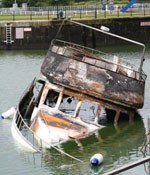When a severe storm approaches, boaters should monitor weather reports to determine the extent of threat to local areas. The right side of a hurricane is the most potentially dangerou section, thus the path of the eye of the hurricane is of critical importance. Also the distance from the center of the hurricane and the category of the storm are vitally important. A nearly direct impact of a severe storm will bring extremes of water levels.
The best protection for boats is a well prepared hurricane plan. Marine facilities, marine-related service organizations and insurance companies expect boat owners to take the time and effort to plan necessary actions to secure and protect their vessels. Thoughtful preparation and delivery of a good plan for boats in a hurricane will allow boaters to attend all the other details necessary to protect their familiy and property during a hurricane.
When Securing Your Boat
- Take all trailers and small vessels out of the water.
- Remove boat plugs or add weight to smaller boats by filling the boat up to half-way with water. Filling it all the way could cause damage.
- Flatten the trailer tires.
- If radio equipment can be removed, take it out. Remove outboard motor and anything that could blow away.
- Store boats and trailers inside if possible.
- If boat must remain outdoors, lash both boat and trailer down with heavy rope or chains anchored to the ground and away from objects that could fall on them.
- Support the trailer axle and prevent the trailer from rolling by placing blocks against each wheel.
- If your boat must remain in the water, tie it together with other boats, at the bows and sterns, separate by protective bumpers.
- Do not tie boats parallel to the shore as waves often capsize or beach vessels in this position.
- Never venture out to sea if a small craft advisory, or hurricane alert is in force.



